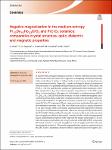Item Infomation
Full metadata record
| DC Field | Value | Language |
|---|---|---|
| dc.contributor.author | Durán, A. | - |
| dc.contributor.author | Reguera, E. | - |
| dc.contributor.author | Mendivil, L. F. | - |
| dc.date.accessioned | 2023-10-05T07:06:02Z | - |
| dc.date.available | 2023-10-05T07:06:02Z | - |
| dc.date.issued | 2023 | - |
| dc.identifier.uri | https://link.springer.com/article/10.1007/s10853-023-08955-w | - |
| dc.identifier.uri | https://dlib.phenikaa-uni.edu.vn/handle/PNK/9474 | - |
| dc.description | CC-By | vi |
| dc.description.abstract | In recent years, raising investigation activity in entropy-stabilized ceramic oxides has been driven by their innovative approach to designing a thermodynamically stable multi-element system, which provides a new focus on investigating complex functional materials. Especially, complex and singular physical properties of orthochromite have generated rising research in recent years. Of this family, the PrCrO3, DyCrO3, and HoCrO3 systems are particularly interesting since, below Néel temperature (TN), they present negative magnetization in the ZFC mode. Here, we have employed this approach and designed a medium-entropy (MECs) Pr1/3Dy1/3Ho1/3CrO3 (PDH) ceramic to study not only whether the magnetic characteristics prevail, but also the state of optical and dielectric properties of this new compound. In addition, the physical properties studied were compared with the single PrCrO3 (PC) compound. | vi |
| dc.language.iso | en | vi |
| dc.publisher | Springer | vi |
| dc.subject | PC | vi |
| dc.subject | In recent years, raising investigation activity in entropy-stabilized ceramic oxides has been driven by their innovative approach to designing a thermodynamically stable multi-element system, which provides a new focus on investigating complex functional materials. Especially, complex and singular physical properties of orthochromite have generated rising research in recent years. Of this family, the PrCrO3, DyCrO3, and HoCrO3 systems are particularly interesting since, below Néel temperature (TN), they present negative magnetization in the ZFC mode. Here, we have employed this approach and designed a medium-entropy (MECs) Pr1/3Dy1/3Ho1/3CrO3 (PDH) ceramic to study not only whether the magnetic characteristics prevail, but also the state of optical and dielectric properties of this new compound. In addition, the physical properties studied were compared with the single PrCrO3 (PC) compound. | vi |
| dc.title | Negative magnetization in the medium-entropy Pr1/3Dy1/3Ho1/3CrO3 and PrCrO3 ceramics: comparative crystal structure, optic, dielectric and magnetic properties | vi |
| dc.type | Book | vi |
| Appears in Collections | ||
| OER - Khoa học Vật liệu, Ứng dụng | ||
Files in This Item:

